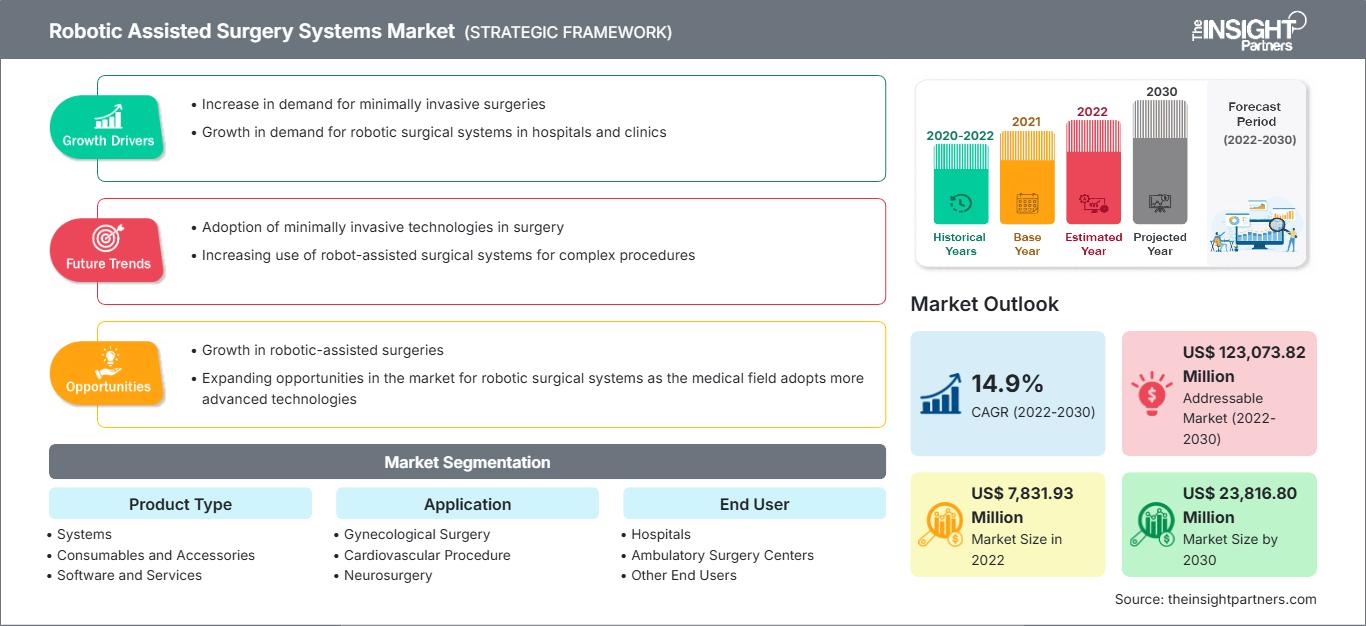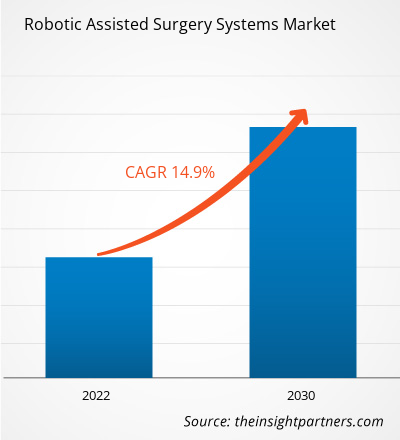[調査レポート] ロボット支援手術システム市場規模は、2022年の78億3,193万米ドルから2030年には238億1,680万米ドルに成長すると予測されており、2022年から2030年にかけて14.9%のCAGRで成長すると見込まれています。
市場分析とアナリストの見解:
ロボット支援手術システム市場には、ロボット工学、画像処理、ナビゲーションシステムを統合し、外科医がより高い精度と制御で低侵襲手術を実行できるように支援する、技術的に高度な手術プラットフォームが数多く含まれています。これらのシステムは、手術能力を高め、患者の転帰を改善し、従来の手術技術の侵襲性を最小限に抑えるように設計されています。ロボット支援手術システムの注目すべき利点には、器用さの向上、3次元視覚化、振戦のフィルタリングなどがあり、外科医は優れた精度と操作性で複雑な手術を行うことができます。これらのシステムにより、外科医はアクセスが困難な解剖学的領域にアクセスできることが多く、外傷の軽減と患者の回復時間の短縮につながります。さらに、手術にロボットを統合することで合併症のリスクが最小限に抑えられ、輸血の必要性が低下し、最終的には術後転帰の改善に貢献します。
成長ドライバーと課題:
ロボット支援手術の利点と機能を調査する研究の増加は、今後数年間の市場の進歩を促進すると予想されます。2022年9月、名古屋市立大学大学院医学研究科のチームが、経皮的腎結石摘出術のためのロボット支援、透視ガイド下、超音波ガイド下の腎アクセスを比較する研究を実施しました。この研究結果は、革新的なロボットデバイスの安全性と使いやすさを実証しており、外科医のトレーニング負担を軽減し、より多くの病院でPCNL手術を実施できるようになる可能性があります。人工知能を搭載したロボットを用いたこの方法は、同様の外科的介入の自動化への道を開き、ひいてはプロセスの迅速化と合併症のリスク低減につながる可能性があります。
慢性疾患症例の増加と低侵襲手術の人気の高まりは、ロボット支援手術システム市場をさらに後押ししています。2022年8月にThe Hinduが発表したニュースによると、インドのハイデラバードにあるApollo Health Cityでは、ロボット支援婦人科手術を500件以上実施しています。 2022年11月、メドトロニックplcの完全子会社であるIndia Medtronic Private Limitedとデリーのベンカテシュワール病院は、Hugoロボット支援手術(RAS)システムを用いた北インド初の泌尿器科治療を完了したと発表しました。
一方、ロボット手術システムの高コストは、医療提供者の財務的実行可能性と事業運営の持続可能性を阻害しています。これらのシステムは、精度の向上、低侵襲性、患者の回復時間の短縮などの利点を提供する一方で、多額の先行投資と継続的なメンテナンス費用が発生するため、医療施設は慎重な財務計画とリソース配分を必要とします。さらに、これらのシステムを操作する外科スタッフには専門的なトレーニングと認定資格が必要であり、運用コストがさらに増加し、ロボット手術を既存の臨床診療に統合することの全体的な経済性と実用性に影響を与えます。ロボット手術システムに関連するコスト負担は、医療費の償還モデルと保険適用の決定に影響を与える可能性があります。ロボット支援下で実施される手術の償還率は変動する可能性があり、保険会社の適用範囲は、これらの技術を導入する経済的根拠に影響を与える可能性があります。これにより、医療施設はロボット手術の臨床的利点と経済的影響を比較検討する必要が生じるという複雑な状況が生じ、さまざまな医療システムにわたる導入のペースと規模に影響を及ぼす可能性があります。
要件に合わせてレポートをカスタマイズ
レポートの一部、国レベルの分析、Excelデータパックなどを含め、スタートアップ&大学向けに特別オファーや割引もご利用いただけます(無償)
ロボット支援手術システム市場: 戦略的洞察

-
このレポートの主要な市場動向を入手してください。この無料サンプルには、市場動向から見積もりや予測に至るまでのデータ分析が含まれます。
レポートのセグメンテーションと範囲:
ロボット支援手術システム市場は、製品タイプ、アプリケーション、およびエンドユーザーに基づいてセグメント化されています。製品タイプに基づいて、市場はシステム、機器とアクセサリ、およびサービスに分かれています。アプリケーション別に、ロボット支援手術システム市場は、婦人科手術、心臓血管、脳神経外科、整形外科、腹腔鏡検査、泌尿器科、一般外科、その他に分類されています。エンドユーザーに基づく市場は、病院、外来手術センター、およびその他のエンドユーザーに分類されます。地理的には、ロボット支援手術システム市場は、北米 (米国、カナダ、メキシコ)、ヨーロッパ (イギリス、ドイツ、フランス、イタリア、スペイン、その他のヨーロッパ)、アジア太平洋 (中国、日本、インド、韓国、オーストラリア、その他のアジア太平洋)、中東およびアフリカに分かれています。
セグメント分析:
製品タイプに基づくと、手術ロボットセグメントは、2022年にロボット支援手術システム市場で大きな収益シェアを占めました。心臓血管疾患と癌疾患の世界的な発生率の急増により、精密で正確な手術を実行するための手術ロボットの必要性が高まると予測されています。アメリカ癌協会の2023年癌統計によると、米国では2023年に190万件の新たな癌症例が報告されると予想されています。オーストラリア保健福祉研究所(AIHW)の2021年報告書によると、オーストラリアにおける2021年の推定新規癌症例数は150,800件でした。オーストラリア統計局の2022年3月の報告書によると、2021年にはオーストラリア人の4.0%、つまり100万人が心臓病を患っていると推定されています。
用途別に見ると、ロボット支援手術システム市場は、婦人科手術、心臓血管外科、脳神経外科、整形外科、腹腔鏡検査、泌尿器科、一般外科などに分類されています。神経学分野は、2022年から2030年にかけて最も高いCAGRを記録すると予想されています。一般手術における手術ロボットの使用増加と、従来の手術方法に対する利点は、市場全体に利益をもたらします。さらに、技術の向上とロボット脳神経外科の成功は、今後数年間でロボット支援手術システム市場の拡大を促進すると予想されます。 SS Innovations Interventional Inc.によると、2020年には世界中で約160万件のロボット手術が行われました。
エンドユーザー別に見ると、ロボット支援手術システム市場は、病院、外来手術センター、その他のエンドユーザーに分かれています。病院セグメントは2022年に市場を席巻し、2022年から2030年にかけて高いCAGRを記録すると予想されています。病院セグメント市場の成長は、複数の経済圏における医療費の上昇に起因しています。病院は最新のロボット支援手術機器を活用することで、質の高いケアを提供しています。さらに、医師や外科医もロボット支援システムを好んでいます。 JAMAネットワークに掲載された論文によると、外科手術全体におけるロボット支援手術の使用は、2013年の1.8%から2019年には15.1%へと数倍に急増しました。
地域分析:
地理に基づいて、ロボット支援手術システム市場は、北米、ヨーロッパ、アジア太平洋、中東およびアフリカ、南米および中米に分かれています。北米は、この市場の成長に最も大きく貢献しています。この地域の市場の発展は、米国における自動化手術器具の使用の増加と次世代ヘルスケアシステムの採用に起因しています。さらに、患者人口に比べて米国では外科医と医療専門家が不足していることが、ロボット支援手術システム市場に有利に働くと予測されています。糖尿病、がん、心血管疾患などの慢性疾患の罹患率の増加は、米国におけるロボット支援手術システムの需要を押し上げています。
従来の手術とは対照的に、低侵襲手術の人気が高まっていることは、ロボット支援手術システム市場にとって追い風となっています。メドトロニック社によると、ヒューゴ社は2022年12月、米国におけるロボット支援手術(RAS)システムの臨床試験を延長し、最初の患者を登録しました。さらに、2022年には、ノースカロライナ州ダーラムのデューク大学病院の医師が、ロボット支援前立腺摘出手術を実施しました。
アジア太平洋地域のロボット支援手術システム市場は、患者数の増加と高度な自動手術器具の使用増加により、2022年から2030年にかけて最も高いCAGRで成長すると予想されています。さらに、現代的なヘルスケア施設の拡大と、最先端医療技術の利点に対する一般の認識の高まりは、将来的にこの地域の市場成長にプラスの影響を与えると予想されています。アジア太平洋諸国の政府は、高度な医療インフラの構築に取り組んでおり、国際企業がこの地域における自動化機器開発施設の設立に投資しています。中国はアジア太平洋地域におけるロボット支援手術システム市場で最大のシェアを占めており、インドは2022年から2030年にかけて最も高いCAGRを記録すると予想されています。中国の手術ロボット事業に携わる企業は、革新的な医療製品の規制承認を迅速化する特別な承認制度を活用することで、市場投入までの時間を短縮しています。さらに、中国では手術ロボットを専門とする医療技術企業がますます多く設立されています。近年、JianJia RobotsとHurwaは、整形外科手術ロボットを専門とする国内企業TINAVIと共同で、手術ロボットソリューションの開発のため中国市場に参入しました。北京市は、TINAVIロボットによる脊椎、股関節、膝関節手術の費用を償還しています。
ロボット支援手術システム
ロボット支援手術システム市場の地域別分析予測期間を通じてロボット支援手術システム市場に影響を与える地域的な動向と要因については、The Insight Partnersのアナリストが詳細に解説しています。このセクションでは、北米、ヨーロッパ、アジア太平洋、中東・アフリカ、中南米におけるロボット支援手術システム市場のセグメントと地域についても解説しています。
ロボット支援手術システム市場レポートの範囲
| レポート属性 | 詳細 |
|---|---|
| の市場規模 2022 | US$ 7,831.93 Million |
| 市場規模別 2030 | US$ 23,816.80 Million |
| 世界的なCAGR (2022 - 2030) | 14.9% |
| 過去データ | 2020-2022 |
| 予測期間 | 2022-2030 |
| 対象セグメント |
By 製品タイプ
|
| 対象地域と国 |
北米
|
| 市場リーダーと主要企業の概要 |
|
ロボット支援手術システム市場のプレーヤー密度:ビジネスダイナミクスへの影響を理解する
ロボット支援手術システム市場は、消費者の嗜好の変化、技術の進歩、製品の利点に対する認知度の高まりといった要因によるエンドユーザーの需要増加に牽引され、急速に成長しています。需要の増加に伴い、企業は製品ラインナップの拡充、消費者ニーズへの対応のための革新、そして新たなトレンドの活用を進めており、これが市場の成長をさらに加速させています。

- 入手 ロボット支援手術システム市場 主要プレーヤーの概要
業界の発展と将来の機会:
世界のロボット支援手術システム市場で事業を展開する主要企業による様々な取り組みは以下の通りです。
- 2023年10月、デピュー・シンセスの整形外科事業であるジョンソン・エンド・ジョンソン・メドテックは、VELYSロボット支援ソリューションを発表しました。このソリューションは、ドイツ、ベルギー、スイスで膝関節全置換手術に使用されています。この発表により、デピュー・シンセスはデジタル手術プラットフォーム内のネットワーク化技術を拡張し、整形外科ロボットに対する未充足の需要に対応します。
- 2022年11月、インドのメドテック企業がナスダック上場の米国企業であるアヴラ・メディカル・ロボティクスと提携しました。SSイノベーションズは、インド初の完全メイド・イン・インドの手術ロボット、SSIマントラを発表しました。これは、市場の他のシステムよりも多くの機能とアプリケーションを備えた高度に開発された外科用ロボットシステムです。
- 2022年11月、米国FDAは、Accelus社のRemi Robotic Navigation Systemのソフトウェアアップデートを承認しました。これにより、外科医は腰椎固定術においてロボット支援下で椎弓根スクリューを配置できるようになります。Accelus社は、脊椎の標準治療として低侵襲手術(MIS)の導入に注力している民間医療技術企業です。
競合状況と主要企業:
ロボット支援手術システム市場では、Intuitive Surgical Inc.、Stryker Corporation、Johnson & Johnson Inc.、SRI International Inc.、Accuray Incorporated、Renishaw PLC、Medtronic PLC、Brainlab、Smith & Nephew PLC、Globus Medical、Zimmer Biometなどが有力企業となっています。これらの企業は、世界中で高まる消費者需要に応えるため、提供サービスの拡充に注力しています。グローバルなプレゼンスにより、幅広い顧客にサービスを提供し、ひいては市場シェアの拡大を実現しています。
- 過去2年間の分析、基準年、CAGRによる予測(7年間)
- PEST分析とSWOT分析
- 市場規模価値/数量 - 世界、地域、国
- 業界と競争環境
- Excel データセット
最新レポート
お客様の声
購入理由
- 情報に基づいた意思決定
- 市場動向の理解
- 競合分析
- 顧客インサイト
- 市場予測
- リスク軽減
- 戦略計画
- 投資の正当性
- 新興市場の特定
- マーケティング戦略の強化
- 業務効率の向上
- 規制動向への対応






















 無料サンプルを入手 - ロボット支援手術システム市場
無料サンプルを入手 - ロボット支援手術システム市場